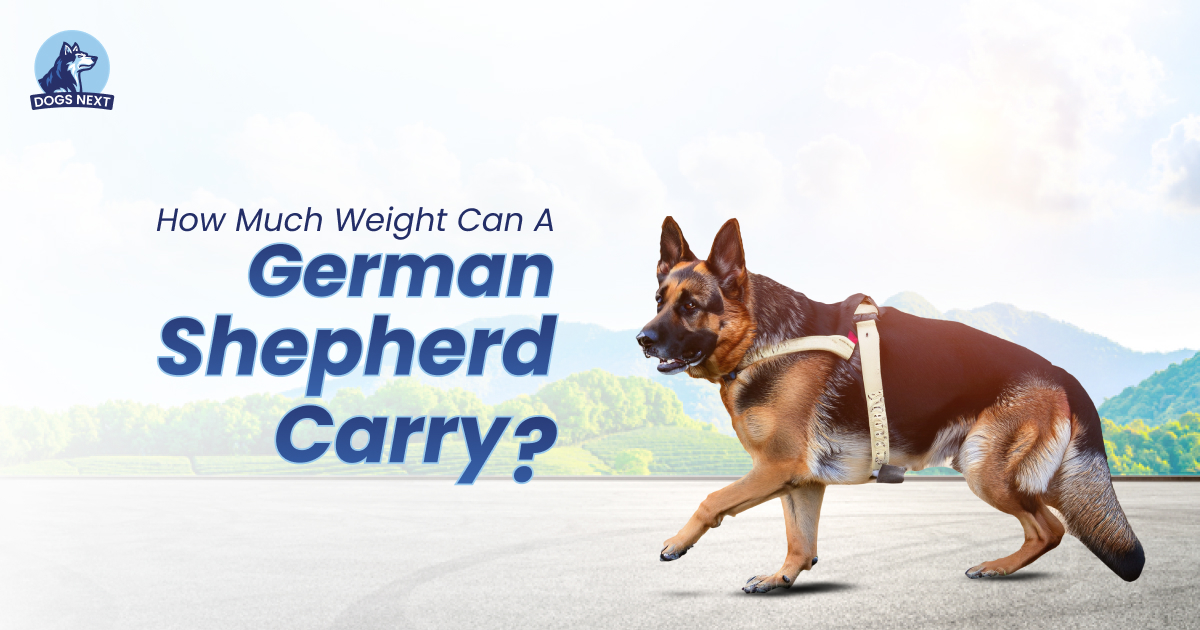German Shepherds have long captivated the hearts of dog enthusiasts with their remarkable intelligence and versatility. Renowned for their loyalty and trainability, these magnificent dogs excel in various roles, from working alongside police and military personnel to being loving family pets. One question that often arises among dog owners and enthusiasts is, “How much weight can a German Shepherd carry?”. The answer is here!
The weight a German Shepherd can carry depends on various factors such as the individual dog’s size, strength, and overall health. On average, a healthy adult German Shepherd can carry around 10% to 25% of its body weight without experiencing significant strain or discomfort.
Understanding a German Shepherd’s ability to bear weight is not only fascinating but also essential for tasks such as search and rescue, herding, and more. In this article, we will delve into the topic, exploring the factors that influence their weight-carrying capacity and shedding light on their incredible capabilities.
Understanding the Strength and Capabilities of German Shepherds
When it comes to weight carrying, both male and female German Shepherds have the potential to handle considerable loads. However, it’s important to note that individual dogs may vary in their capacity based on factors such as size, age, and overall health.
In terms of physical characteristics, German Shepherds possess a well-built, muscular body. They have a sturdy frame with a strong skeletal structure, which contributes to their ability to carry weight effectively. Their deep chests and robust shoulders provide the necessary support for bearing heavy loads.
To provide a rough estimate of their weight carrying, let’s consider the average weight of a male German Shepherd, which typically ranges between 65 to 90 pounds (29 to 41 kilograms).
Based on this weight range, a German Shepherd could potentially carry between 7 to 20 pounds (3 to 9 kilograms) comfortably.
Here’s a brief breakdown of the physical characteristics and athleticism of German Shepherds:
| Physical Characteristics | Description |
| Size | Medium to large breed, with males typically larger than females |
| Weight Range | Males: 65-90 pounds (30-41 kilograms); Females: 50-70 pounds (23-32 kilograms) |
| Muscular Build | Well-defined muscles, especially in the shoulders and hindquarters |
| Athleticism | Agile, with excellent endurance and stamina |
| Body Structure | Strong and well-proportioned, allowing for efficient weight distribution |
Apart from their physical attributes, German Shepherds have a rich history as working dogs. Originating from Germany, they were initially bred for herding and protecting livestock. Over time, their intelligence, trainability, and remarkable work ethic led them to excel in various tasks, including search and rescue, police work, assistance, and more.
Factors Influencing a German Shepherd’s Carrying Capacity
When considering a German Shepherd’s weight-carrying capacity, several factors come into play. These factors include body structure, musculature, size, age, and overall health.
- The body structure of German Shepherds, characterized by their sturdy build and well-defined muscles, provides a solid foundation for carrying weight. Their musculature, particularly in the shoulders and hindquarters, contributes to their strength and ability to handle loads efficiently.
- Size is another factor to consider. Generally, male German Shepherds tend to be larger and heavier than females, which may give them a slight advantage in terms of carrying capacity. However, individual variations within the breed are common, and a smaller-sized German Shepherd can still exhibit impressive strength.
- Age and overall health are crucial considerations as well. Younger German Shepherds may still be developing physically and may not have reached their full weight-carrying potential. Additionally, any underlying health conditions or injuries can affect a dog’s ability to carry weight comfortably and safely.
By taking into account these factors, you can better understand and appreciate the weight-carrying capacity of German Shepherds while ensuring their safety and welfare in activities that involve carrying loads.
Training and Conditioning for Carrying Tasks
Proper training and conditioning play a vital role in enabling German Shepherds to excel in carrying tasks. Training not only enhances their strength and endurance but also ensures their safety and prevents injuries. Here are some key considerations when preparing German Shepherds for weight-carrying tasks:
Gradual Progression: Start with lighter loads and gradually increase the weight over time. This allows their muscles to adapt and develop strength gradually without straining themselves.
Obedience Training: Teaching your German Shepherd basic obedience commands such as “sit,” “stay,” and “heel” helps establish control and discipline during carrying tasks.
Core Strengthening Exercises: Engage your German Shepherd in exercises that target their core muscles, such as sit-ups, balance exercises, and walking over obstacle courses. These exercises help develop stability and overall body strength.
Endurance Training: Incorporate activities like long walks, jogging, or swimming sessions to improve their cardiovascular fitness and stamina.
Positive Reinforcement: Utilize positive reinforcement techniques, such as treats and praise, to motivate and reward your German Shepherd during training sessions. This creates a positive association with the carrying tasks.
Determining an Individual German Shepherd’s Weight-Carrying Limit
While general guidelines can provide an idea of a German Shepherd’s weight-carrying capacity, it is crucial to assess each dog individually. Here are a few methods to help determine an individual German Shepherd’s weight-carrying limit:
- Body Condition Evaluation: Assess your German Shepherd’s overall body condition, including their weight, muscle tone, and overall health. A veterinarian can guide in determining their suitability for weight-carrying activities.
- Trial and Observation: Start with a reasonable load and observe your German Shepherd’s behavior during the carrying task. Look for signs of discomfort, fatigue, or any physical limitations. If they handle the load comfortably, you can gradually increase the weight.
- Professional Evaluation: Consult with a veterinarian or a professional dog trainer experienced in working with German Shepherds. They can assess your dog’s physical condition, evaluate their gait and movement, and provide valuable insights into its weight-carrying potential.
Remember, it’s essential to prioritize your German Shepherd’s well-being and avoid pushing them beyond their physical limits.
Common Tasks for German Shepherds that Involve Carrying Weight
Search and Rescue: German Shepherds are often trained to carry essential supplies, and rescue equipment, or even assist in locating missing individuals during search and rescue operations.
Herding: German Shepherds have a natural herding instinct and can be trained to carry herding sticks or other tools while guiding livestock.
Assistance Dogs: Some German Shepherds are trained as service dogs and may be taught to carry items like medication, water bottles, or mobility aids to assist their owners.
Safety Considerations and Precautions for German Shepherd Puppies
- Proper Weight Distribution: Ensure that the weight is evenly distributed on a puppy’s body to prevent strain or injury. Use appropriately fitting harnesses or backpacks designed for canine use.
- Monitoring Well-being: Regularly observe your puppy during carrying activities to watch for signs of fatigue, discomfort, or any physical limitations. Take breaks and adjust the weight if needed.
Caring for German Shepherds Engaged in Weight-Carrying Tasks
- Diet and Nutrition: Provide a balanced and nutritious diet suitable for active dogs, ensuring they receive adequate protein, vitamins, and minerals. Consult with a veterinarian for specific dietary recommendations.
- Rest and Recovery: Allow your German Shepherd sufficient rest periods between weight-carrying activities. This allows their muscles to recover and prevents overexertion or strain.
It is important to further research and consult with professionals to ensure the safety, well-being, and proper training of your German Shepherd when engaging in weight-carrying tasks.
Frequently Asked Questions
Q: How much weight can a German Shepherd carry on its back?
Ans: The weight a German Shepherd can carry on its back varies depending on factors like size, conditioning, and individual capability.
Q: How heavy is a German Shepherd in KG?
Ans: On average, a German Shepherd weighs between 30-41 kilograms (65-90 pounds) for males and 23-32 kilograms (50-70 pounds) for females.
Q: How do you carry a German Shepherd?
Ans: When necessary, you can carry a German Shepherd by supporting their hindquarters and chest, ensuring its weight is evenly distributed and avoiding strain.
Q: How much weight can a German Shepherd pull?
Ans: They can pull significant weights, depending on their size, training, and physical condition.
Conclusion
In conclusion, German Shepherds possess impressive strength, intelligence, and athleticism, making them well-suited for tasks that involve carrying weight. While the general weight-carrying capacity may vary between individual dogs, factors such as body structure, musculature, size, age, and overall health play a significant role. Proper training, gradual progression, and conditioning are crucial in developing their strength and endurance.
When engaging in weight-carrying activities, it’s important to prioritize the well-being and safety of your German Shepherd. Regular monitoring, appropriate weight distribution, and providing adequate rest and nutrition are essential. So, if you’ve ever wondered, “How much weight can a German Shepherd carry?” the answer lies in their incredible strength and their potential to handle significant loads. Good luck!

I’m David, an expert contributor and writer, with two furry friends of my own, I know the challenges of raising and caring for dogs. From training to nutrition and health, my goal is to provide valuable insights and advice to help create strong bonds and happy, healthy lives. Find me in Twitter.




